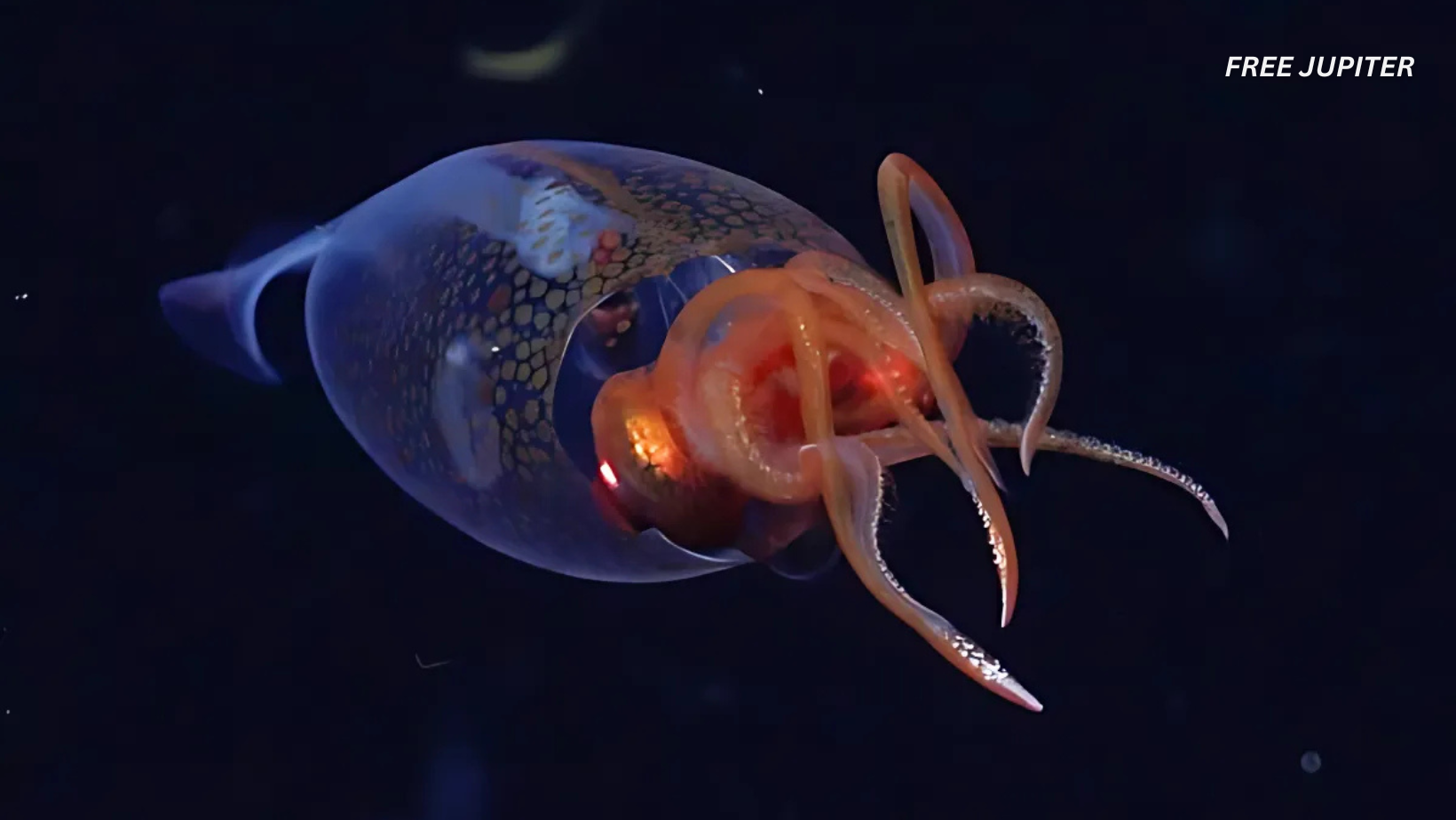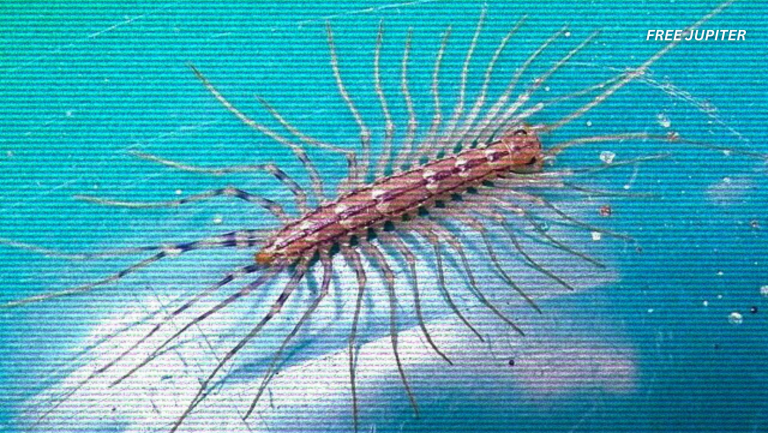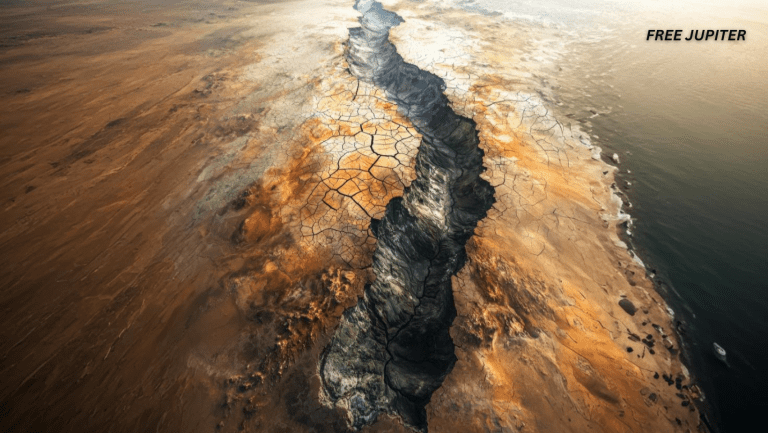In a landmark moment for marine science, a juvenile colossal squid has been filmed alive in its natural environment for the very first time, marking a groundbreaking discovery more than a century after the species was first identified and named. This rare and extraordinary event unfolded during a recent scientific expedition conducted by the Schmidt Ocean Institute, which announced the historic footage.
The elusive creature was encountered on March 9, deep in the icy waters surrounding the South Sandwich Islands in the southern Atlantic Ocean. The moment occurred as part of a 35-day expedition led by an international team of researchers dedicated to exploring uncharted marine biodiversity in some of the planet’s most remote and inhospitable seas.
According to Michelle Taylor, the chief scientist of the expedition and a professor at the University of Essex, the capture of this footage is nothing short of monumental. “This is a once-in-a-lifetime situation; these types of discoveries don’t come along very often,” Taylor remarked in an interview with ABC News. Her excitement echoed the sentiments of an entire scientific community that has long sought to observe this mysterious creature alive in its native habitat.
The astonishing footage was recorded by a remotely operated vehicle (ROV) deployed by the institute. At a depth of nearly 1,100 feet below the ocean’s surface, the ROV captured the ghostly figure of a translucent squid measuring approximately one foot in length—an individual believed to be a juvenile member of the colossal squid species, Mesonychoteuthis hamiltoni.
This occasion marked the very first confirmed sighting of a colossal squid moving freely in the deep sea. Until now, knowledge of the creature had been limited to specimens that were either captured or accidentally hauled to the surface by fishing vessels. These unfortunate events often left the animals damaged or in poor condition, offering only limited insights into their biology and behavior.
“It’s very challenging to understand the biology, ecology, and behavior of an animal if you’ve only ever seen dead specimens or ones that have been brought to the surface,” Taylor explained. “Seeing this squid in the midwater zone, which is its natural home, gives us a completely different understanding. You get a real feel for its behavior and how it interacts with its environment.”
Read more: Iceberg Breaks Off Of Antarctica, Revealing Strange Tentacled Creatures Hidden Underneath
The squid’s delicate, almost glass-like appearance stunned the researchers at first. Taylor admitted that her team initially did not recognize the true identity of the creature. In fact, there was no expert on board at the time who could confirm the sighting as a colossal squid. The realization only began to dawn when someone tuning in to the livestream of the ROV footage made a startling comment: “Is that a juvenile colossal squid?”
“We were already quite mesmerized by this stunning little squid,” Taylor said, describing the team’s reaction. “But then to discover that it might be something as significant as a juvenile colossal squid—it was truly a beautiful and unforgettable moment.”
While the individual filmed was relatively small, adult colossal squids are anything but. These deep-sea giants are estimated to reach lengths of up to 23 feet and can weigh as much as 1,100 pounds, making them the heaviest invertebrates on Earth. Though the giant squid (Architeuthis dux) may hold the title for length, it is the colossal squid that is considered the “beefiest,” as Taylor jokingly described.
Among the species’ most notable anatomical features are the hooks embedded in the middle of its eight arms—an adaptation believed to aid in hunting and grasping prey in the pitch-black depths of the ocean. These unique characteristics set the colossal squid apart from many of its cephalopod cousins and fuel the ongoing fascination surrounding this rarely seen species.
Despite being first described scientifically over 100 years ago, the colossal squid remains one of the most poorly understood marine animals. Its preferred habitat lies deep beneath the Southern Ocean, where harsh conditions and extreme depths make human exploration exceedingly difficult. As a result, scientists have been left to piece together fragments of knowledge from washed-up specimens, deep-sea trawls, and rare encounters.
The Schmidt Ocean Institute’s ROV footage is being hailed as a transformative step toward unlocking some of the many secrets that continue to surround this enigmatic creature. In recent years, the institute has made a series of notable contributions to the study of deep-sea squid. According to their press release, the organization has now captured footage of at least four squid species never before seen in their natural environments, including the Ram’s Horn Squid in 2020 and the Promachoteuthis in 2024. One additional species has been filmed as well, though it has yet to be officially confirmed.
“These unforgettable moments continue to remind us that the ocean is brimming with mysteries yet to be solved,” said Jyotika Virmani, the Schmidt Ocean Institute’s executive director. Her words echoed a growing sentiment in the scientific world: that the vast, uncharted oceans of our planet may hold even more secrets than the stars above.
Read more: 4,000 Meters Below The Sea, Scientists Have Finally Found the Incredible ‘Dark Oxygen’
Taylor also hopes that this discovery will encourage the public to view the ocean with renewed wonder and curiosity. She pointed out that while much attention and funding is often directed toward space exploration, the depths of our own oceans remain vastly unexplored and poorly understood.
“People want to go into space, and we have all this beautiful, uncharted territory on our own planet,” Taylor said. “There are still so many amazing, incredible things left to discover; we’ve only scratched the surface.”
Indeed, the deep sea continues to be one of Earth’s last frontiers. It is a realm filled with otherworldly creatures, extreme pressures, and eternal darkness. Yet it is precisely because of these conditions that life in the deep ocean has evolved in such bizarre and fascinating ways. From bioluminescent fish to transparent invertebrates, the diversity of life found here defies human imagination.
The colossal squid has long held a place in maritime legend and scientific curiosity alike. Its massive size, elusive nature, and association with ancient seafarers’ tales—many of which described monstrous creatures lurking beneath the waves—have earned it a mythic status. However, with modern technology and dedicated research expeditions, these myths are gradually giving way to real scientific understanding.
Read more: Unraveling The Mystery Of The Indian Ocean’s ‘Gravity Hole’
The implications of the recent footage extend beyond just this one sighting. It provides a valuable opportunity for researchers to analyze the squid’s movement patterns, body structure, and behavior in real-time. Furthermore, it raises important questions about the environmental factors that support such deep-sea life and how climate change or human activity might impact these delicate ecosystems.
As exploration tools become more advanced and accessible, it is hoped that more of these awe-inspiring discoveries will follow. With each expedition, researchers gain a deeper appreciation of the intricate web of life that exists beneath the ocean’s surface—a web that includes not only charismatic megafauna like whales and squid, but also countless smaller organisms that play critical roles in maintaining ecological balance.
For now, though, the image of that shimmering, translucent squid drifting through the deep remains seared into the minds of those who witnessed it. A fleeting glimpse into a world few will ever see in person—but one that continues to reveal its wonders, one frame at a time.










